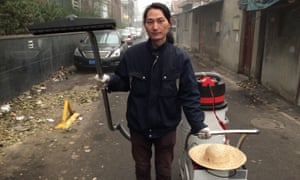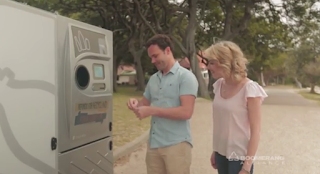Do you have a second amazed by the thinness, the length and the height of the bridge. It is actually a built project in Zhangjiajie Grand Canyon which is made of glass!!!! It is 300 vertical height from the ground, 430 meters long, and 6 meters wide.
The construction of the skybridge that stretch 1,410ft between two cliffs
This is the second glass bridge built in the national park in China. The first one attracted a lot of tourist to the national park which brings quite a lot of economic benefits to the Chinese government. In order to build this "super" structure, many trees are cut down and the nearby landscape has been affected. Also, there is water pollution problems caused by the construction. Despite all the air and water pollution created from the production of glass, the glass may needs replacements once a while. The wildlife habitat in the area was affected in the construction stage but what caused me worried is the number of tourist attracted to this tourist attraction. Also, the future development to the area such as housing, hotels and other related developments to boost the tourism. In 2011, there are 30,410,000 tourist travelled to Zhangjiajie Grand Canyon in a year. This is already a high number of people that caused a burden for the environment in Zhangjiajie . I believe more developments like hotels and housing are coming in the next 10 years, as there are only 854 hotels (55,300 beds) in the area.
As a fast growing country like China, the economic development are happening rapidly over the country and less attention were paid to the natural environment and the sustainability issues, people are designing taller buildings, longer bridges. And with the development of technologies, lots of the materials and structures are prefabricated, decisions were made within a shorter time-frame, consequences to the nature were not put into account while these decisions were made.
As a fast growing country like China, the economic development are happening rapidly over the country and less attention were paid to the natural environment and the sustainability issues, people are designing taller buildings, longer bridges. And with the development of technologies, lots of the materials and structures are prefabricated, decisions were made within a shorter time-frame, consequences to the nature were not put into account while these decisions were made.
In conclusion , I think a developed countries should be reflected on the result of education e.g How people perform as a part of cities and respecting the nature, but not striving for a taller buildings or longer bridges to break the world records.
Reference:
World's highest glass bridge in China to include three crazy swings. (n.d.). Retrieved June 02, 2016, from http://inhabitat.com/worlds-highest-glass-bridge-in-china-to-include-three-crazy-swings/
(n.d.). Retrieved June 02, 2016, from http://www.zhangjiajietourism.us/press-factsheet.html
(n.d.). Retrieved June 02, 2016, from http://www.telegraph.co.uk/travel/destinations/north-america/united-states/articles/Grand-Canyon-threatened-by-development/
(n.d.). Retrieved June 02, 2016, from https://en.wikipedia.org/wiki/Grand_Canyon_Skywalk#Environmentalists
(n.d.). Retrieved June 02, 2016, from http://www.telegraph.co.uk/travel/destinations/north-america/united-states/articles/Grand-Canyon-threatened-by-development/
(n.d.). Retrieved June 02, 2016, from https://en.wikipedia.org/wiki/Grand_Canyon_Skywalk#Environmentalists













